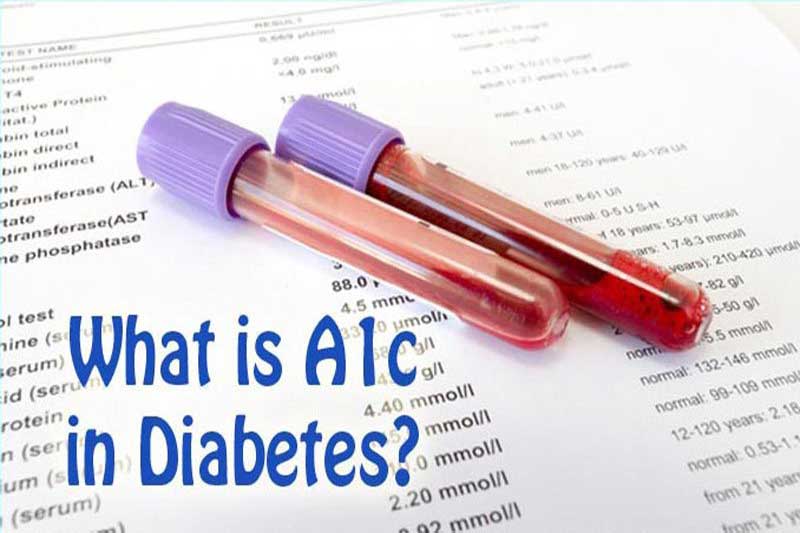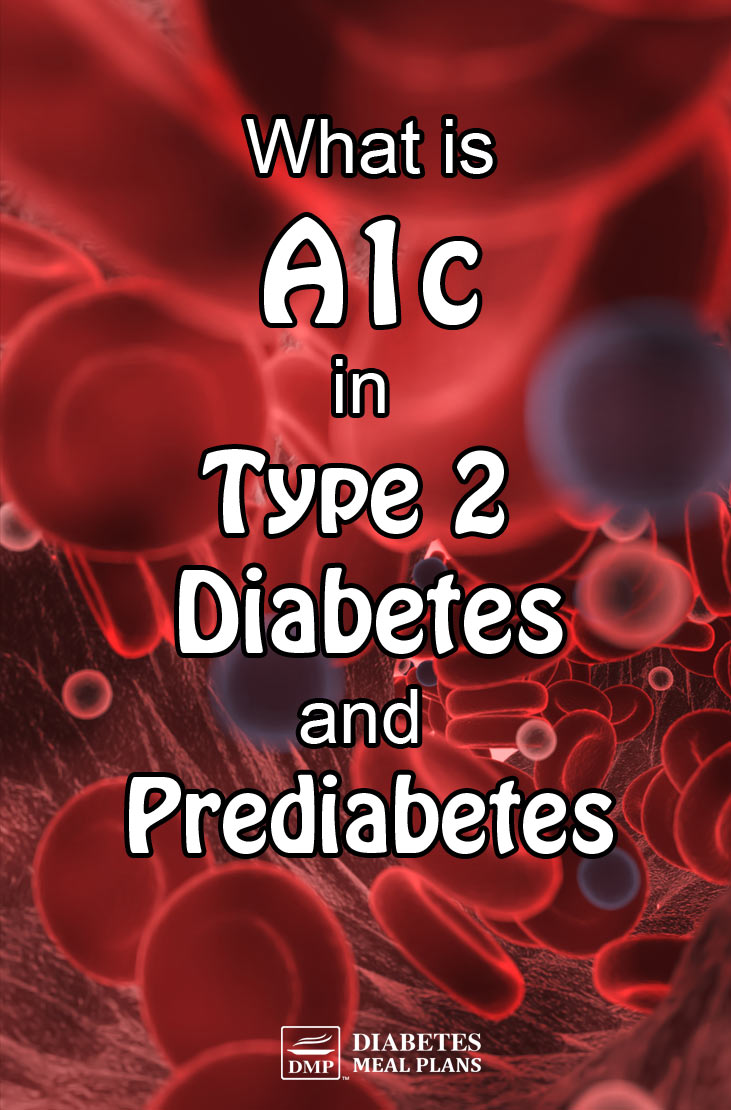Table of Contents[Hide][Show]
It sounds like some kind of strange disease doesn’t it? But in fact it’s just another way to measure blood glucose control and below we’ll explain all about it.

What Is A1c?
The A1c is short for Hemoglobin A1c, so you’ll sometimes see it written as HbA1c as well.
The A1c is a blood test that is ordered by your physician to diagnose prediabetes and type 2 diabetes, or to assess how well you’re going with your diabetes management.
The A1c test measures your average blood sugar levels over the past 2-3 months. The test results will be provided in a percentage (%).
Hemoglobin is our blood, and a process called glycosylation occurs where sugars (glucose) in your bloodstream attach to hemoglobin, the protein in red blood cells that carries oxygen. The average red blood cell lives for around 3 months, so when they are doing this blood test they are testing glycated hemoglobin – the amount of sugar/glucose that is attached (stuck) to the red blood cells.
What Are Normal A1c Results?
The measurement that we get given from an A1c test is usually a percentage (%) and it’s most commonly expressed as the percentage of total hemoglobin.
The generally accepted target range for A1c worldwide is between 4-6%. However, to make things confusing, there is some variation.
For instance, the “normal” A1c in the US is under 5.7%, while the rest of the world is under 6%.
What this means is that if you live in the US and your test results come in over 5.7%, you will be diagnosed with prediabetes. While if you’re in Canada, the UK or Australia, you will be diagnosed with prediabetes if your A1c is over 6%.
Diagnostic ranges for A1c test results
US
- Under 5.7% is normal
- 5.7% to 6.4% prediabetes
- Over 6.5% type 2 diabetes
UK, AUS, CANADA, etc
- Under 6% is normal
- 6% to 6.4% prediabetes
- Over 6.5% type 2 diabetes
It is ridiculous that levels are not set at a consistent level around the globe, but hopefully one day they will be, as there will be a lot less confusion for everyone.
If you have prediabetes, read more about A1c for prediabetes here.
A1c in mmol/mol
In some countries, A1c is measured in mmol/mol instead of a percentage. This unit directly represents the ratio of glycated hemoglobin in a different scale. Although the measurement system varies, the information remains the same: it reflects your average blood sugar levels over the past 2-3 months.
Below is a table to help translate between the two units:
| A1c (%) | A1c (mmol/mol) |
|---|---|
| 6.0 | 42 |
| 6.5 | 48 |
| 7.0 | 53 |
| 7.5 | 58 |
| 8.0 | 64 |
| 8.5 | 69 |
| 9.0 | 75 |
| 10.0 | 86 |
How Does A1c Relate To Blood Glucose Results?
The American Diabetes Association now recommends the use of a new term in diabetes management called “estimated average glucose,” or “eAG.”
It’s a way that health professionals can report an A1c result to you in the same measurements you’re used to, either mg/dL or mmol/L.
Here is a chart that shows a rough estimate of how A1c and blood glucose relate to one another.

This chart gives you a general range to evaluate the average glucose levels you’ve been running at. For instance, if your A1c test comes back at 7%, your average level for blood sugar has been around 154 mg/dL (8.5 mmol/L).
It’s not entirely accurate, just a general average because daily blood sugar levels do fluctuate, sometimes quite dramatically.
Benefits of An A1c Test?
The benefit of measuring A1c is that it does give a more objective look at your blood glucose control because it can’t be influenced by short term things like meal changes, infections, acute glucose changes etc.
For instance, you might have a meal one day packed with high carb foods, which results in high blood sugar. Your day-to-day finger stick blood sugar monitoring can be influenced by this but your A1c won’t. It is a reflection of the combined 2-3 months, which is why A1c tests are routinely ordered every 3-6 months.
With this in mind, an A1c test is more precise, providing valuable information to help you achieve better blood glucose control.
Please pin, tweet or share; then keep on reading.

Is The A1c Test Accurate?
There can be a 0.5% variation in accuracy for test results.
For example, if your tests says 7%, it could be anywhere in the range of 6.5-7.5%.
Can You Have A High A1c and Normal Fasting Glucose?
While it’s not usual, it is possible – you can have a high A1c and normal fasting glucose, or you might have a high fasting glucose and normal A1c.
This does sound strange but all tests are really just indicators, so if the results come back mixed, your doctor will probably send you for follow up tests just to see what’s going on.
Is A1c Used To Diagnose Diabetes and Prediabetes?
Yes. It is commonly used alongside other blood glucose tests such as a fasting blood glucose test and/or a glucose tolerance test.
Why Is It So Important To Lower A1c?
High blood sugar levels (hyperglycemia), indicated by a high A1c, causes diabetes complications such as nerve damage (neuropathy), eye problems (retinopathy), kidney disease (nephropathy) and other things no one likes to think about.
Therefore, lowering blood sugar and A1c within a healthy range, is critically important to your health.
What Is My A1c Goal?
Overall it is recommended you try to reach an A1c that is within the normal healthy range of 4-6%.
However, organizations such as the American Diabetes Association, along with Canadian and Australian diabetes organizations recommend that for people with type 2 diabetes, keeping A1c under 7% is an appropriate goal.
Depending where your percentage is now, your physician or healthcare team may also set your A1c a little higher, such as 8%. If your A1c is over 10%, then 8% is certainly a great starting goal!
Overall, if your A1c is currently above 7%, try first aiming for 7%. Then once you get there, if you can, aim to bring it down within a normal range of 4-6%.
It can take a while to lower A1c levels, but it is entirely possible.
How Do You Lower A1c?
You lower your A1c in the same way you lower your blood sugar – through diet and lifestyle changes, and medication if necessary.
- Eat a healthy low carb diet, cutting back on the high carbohydrate foods by focusing on eating the right type of carbohydrates
- Exercise regularly – at least 30 minutes most days
- Live a healthy lifestyle – sleep well, stress less, meditate, engage in healthy behaviors, have fun
- Take our 30 Day Turnaround Program or Join as a Meal Planning Member – many of our members have lowered their A1c levels back to normal, even after having type 2 diabetes for over a decade!
Gloria G shares:
“I wanted to share my great results having been on this plan for only one month. 3 months ago my A1C was 8.7 and my recent blood work showed it at 7.4. My endocrinologist was very impressed and thinks I will be at the target level by my next testing in 3 months.”
Sheryl shares:
“After about 3 months on your plans, my doctor’s report was best ever: A1c was normal for the first time since I was diagnosed diabetic in 2007! After one year I now am taking fewer medications and am maintaining an A1C of 5.8! Keep up what you do! You have earned my trust! “
Get proactive and you can also achieve the same A1c improvements many of our members see.
Changing habits can be challenging, but with a little commitment, determination, and work (yes sometimes it will feel like work), you can lower A1c levels.
The good news is, lowering your A1c levels is well worth the effort for the great health benefits you receive!


Sony
I was just diagnosed yesterday with Diabetes2. My levels were very high and was prescribed metaforim to help.
I’m beating myself up as I did not really take seriously the impact of poor nutrition and exercise like I should have. I’ve always been a big girl, am now 61 weighing Roght around 200. My A1-c was 11.3 which from all I’ve read is really high.
I started last week removing all carns( my biggest food source), diet sodas, sweets, processed foods and started walking. Lost 6lbs in 7 days and will be working on increasing better foods and exercise.
I’ve seen several posts about lowering glucose. How long does that take? Any tips that would help – it’s all a bit overwhelming. I know I can do it
Thank you.
JD admin
Hi Sony, great effort so far! The great thing is, you can always improve your health. Lowering daily glucose can happen fast, within days, but since an A1c is a reflection of average glucose over a 3 month period, you need to allow 3 months for this to come down. 11.3 is high, so it will take some time to bring down to a normal level of <6. Step-by-step, but it can be done.
Please refer to the free resources on our site for help. Or you might consider joining us as a member.
[email protected]
My question is for Emily. In last 15 yrs i have been dx with failed back syndrome (5 lowback surgeries, current pain control w infusion morphine pump, working ok), then i had a brain meningioma around optic nerve. (Blind in l eye), at which time it was discovered i have MS (current tx IVIG 4 hr monthly infusion), next cervacal cancer level 3c (6 chemo, 5 chemo/radiation, \5brachy), today type 2 diabetes. What diet am i looking for????
Emily - Dietitian (MS, RD)
I would definitely recommend that you find a dietitian who can really individualize your needs! With so many different factors its hard to recommend a “one size fits all diet.” As we continually encourage, a low carb diet can be very beneficial for getting your type 2 diabetes under control, but there may be certain caveats or modifications that a dietitian could make that would also suit the other things going on in your life.
Subhash
My A1c 6.8 I start green juice
And vegitable last 1 week
Can my A1c can go down ?
I am pure vegitarian .
And what about grape juice
It is good for me.?
Emily - Dietitian (MS, RD)
A1c is typically checked every 3 months; you will not see drastic changes in A1c after just a few days. You may find the vegetarian food list healthful, and definitely stay clear of all juices.
Craig
I have a 72 year old sister with cerebral palsy that was diagnosed t-2 about two months ago. The doctor put her on 1000 met in the morning and 1000 in the evening. [although I have only been giving her 500 in the p.m.] Reduced carb diet [50-80 total] usually. Net carbs. Originally her A1C was 13. Glucose 300. Glucose now avg 135-140. Had some in the 115-120 range offset by some in the 160-180 range. A1C we’ll know in about five weeks. My question is most of the veggies that you recommend for the t-2 diet she will not eat. She loves potatoes- mac and cheese etc… We still give her some but we really don’t have a lot of options. My concern is the restrictions that she has is she getting the nutrients that she needs. I give her a multi-vitamin that hopefully will help. Any suggestions?
Emily - Dietitian (MS, RD)
Hi Craig, two suggestions that come to mind are trying mashed cauliflower (to replace the potatoes) and using cheese sauce to make some of the new vegetables more appealing to your sister! Use very limited portions of potatoes and/or mac & cheese as the foods will certainly push her over the 50-80g range. You may want to read more about net carbs vs total carbs over here; in general we encourage you to count total carbs.
Including a wide variety of foods, including different colored vegetables, protein, and healthy fat should ensure adequate vitamins and minerals, however a multivitamin never hurts- especially if there is some restriction on acceptable foods. Keep us updated on her next A1c!
Lynn Ellis
I was diagnosed T2 last March, so it’s been a year. I went for my annual checkup and blood tests this past Wed. As the doctor was leaving the room he came back and tapped me on the shoulder and said, “You are doing excellent. I want you to know that, so don’t sweat the small stuff.” This was because I told him I worry when my daily glucose goes up a bit, like 8.3 or thereabouts. He said as long as I have my A1C down below 6 that is good and he has no doubt these test results will be very good, too. I have been following the low carb/high fat lifestyle since probably last May or June and went from 155 lbs to 113 lbs, the lowest I’ve ever been. My bad chol is down and my good chol is up and I’m not on any meds. I am grateful for all the information on this site, although I do have to say I’m not very consistent with being on here. I also applaud all the folks on here who are doing very well, too. Keep up the good work, everyone.
Emily - Dietitian (MS, RD)
Congrats on all that you have accomplished so far, Lynn Ellis! Your doctor may be hinting at the fact that stress in and of itself stress can raise blood sugar levels. When you do experience a high, focus on WHY/HOW it happened (eating something out of the ordinary, forgetting to take medication as prescribed, lack of physical activity) and what your plan of action is the next time around.
Austin Samara
Hello Jedha
I am a type two diabetic last month my sugar level reads in the morning 156ml to 160 every morning
I follow a strict diet and walk about 2 to 3 miles on my thread mill every evening
after walking blood pressure come down 110 or less
I only have glass of Red wine Saturday night ( one half a glass)
I take blood pressure tablets as I have had a heart by pass
I am very fit only eat quality food
also take 30 mg of diamicrom and 5 mg of Tragenta to control diabetes please what do I have to do to reduce my sugar in blood
Emily - Dietitian (MS, RD)
High morning sugar can be a common problem for many people with diabetes. Since I don’t exactly know what you mean by ‘quality foods’, here is a list of blood sugar friendly foods that should help with your overall control. Also make sure to keep up the exercise as that will help too!
Leticia
What if my sugars are low in the morning but high in the afternoon
Emily - Dietitian (MS, RD)
We’ll need a bit more information to help guide you in the right direction, Leticia! What time do you eat dinner and how many hours are you fasting before eating breakfast? What is your sugar level in the morning usually? Have you considered what you might be eating midday that could be causing a rise in sugar level in the afternoon? If appropriate, adding some midday exercise could also help prevent the higher readings in the afternoon. If you are taking any medication, or even certain supplements, you might want to speak with your doctor about the timing of those medications to help even out your levels as well.